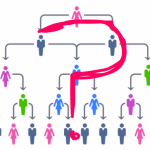Traditional style hierarchies are no longer appropriate for today’s markets. Our world is changing too fast and the prevailing style of management that creates silos cannot react quickly enough. What is a realistic alternative?
We receive a wealth of comments and questions about our work on developing a systemic way of working. A recent long comment on our blog post ‘Schools as Centers of Innovation?’ from Liz Alexander was both astute and pertinent. There is not enough space in one post to reply to all her spot-on questions. Here I’d like to start responding to Liz’s words that sum up a major problem with hierarchies in our age of complexity when the ability to think differently is key:
“Given the power dynamics that still exist in most hierarchically structured organizations, for example, its leaders don’t want people to think for themselves, in the main. That’s why those of us that do “think different” don’t work in corporate America.”
So why do we have hierarchies in the first place?
Let’s go back and examine why hierarchies are there at all. People are very attached to hierarchies and for good reason. They have been ingrained in our psyches for centuries. Even biblically, Moses was advised by his father-in-law Jethro to create a hierarchical structure of judges to help him administer justice to the people and not exhaust himself. The problem with hierarchies today is that they create artificial barriers, ceilings and silos. These blockages inhibit the efforts to achieve the overall goal. This is a critical problem today when what organizations need to focus on is maximizing quality, involvement and flow.
Misunderstanding complexity
Traditional hierarchy with its mindset of separation reflects a Newtonian, mechanical worldview where it is believed that the whole equals the sum of its parts. This mindset is further entrenched by a set of measurements/rewards (cost accounting) that encourage local optima. It is a lack of understanding of complexity that leads organizations to still manage today with vertical hierarchy and functions. They believe that in order to cope with complexity they have to “break the complexity down” into components. This is based on the false assumption that separation is the simplest way to handle complex reality.
The driving pace of the digital era
Today, instead, we live in a world of increasing speed due to digitalization and of increasing complexity due to the expansion of interdependencies. In an increasingly digital world where speed and complexity dominate, organizations urgently need:
- Visibility of the entire value chain from supplier to customer
- Understanding of the flow of processes and projects
- A learning cycle based on feedback
In this way, an organization can become fully cognizant of:
- the entire context in which it operates;
- how interdependencies work and can be continuously improved both internally and externally.
Far from alienating those who think differently, corporations in order to survive and thrive must cultivate systemic thinking skills throughout the organization.
We stand on the shoulders of giants
How do we do it? How do we make the transition away from a model that seemed to work for centuries but that no longer cuts it? First of all, we do not have to invent the wheel and we do not have to abandon the concept of hierarchy. The knowledge, understanding and tools have already been developed for a contemporary organization to function systemically. We have found these aspects to have been fully addressed in the work of W. Edwards Deming, the ‘father’ of Quality and Dr. Eli Goldratt who developed the Theory of Constraints for management. We have developed a management methodology that integrates the work of these two management thinkers into a coherent path for designing and managing organizations as silo-free systems.
A systemic organization is one where all the emphasis is given to:
- increasing the flow of work towards the goal, and this is done by understanding that work is essentially consists of processes and projects,
- creating the quality necessary to thrive and,
- by removing artificial barrier’s to people’s motivation and intelligence, fostering the involvement that allows employees to learn and grow.
Operationally, all the work of an organization is organized into projects of various dimensions. The ‘hierarchy’ is no longer vertical but based on responsibility for those projects.
How hard is it to make this transition into a new way of working? We do not have to do the impossible, but we must have the courage to do what is in our power. We can take the journey one step further. The dynamics of transformational change are not linear and so we can never know the overall effect of even a small change. Even the small part that we may play in bringing transformation is a cumulative part added to the work already done. The important thing is to start working at the shift.
We present a new model for a systemic organization in detail both in terms of the thinking behind it and how to conduct operations in our new book ‘Quality, Involvement and Flow: The Systemic Organization’. We also tackle the question of how businesses schools are lagging behind, what they are not currently teaching and what we believe they should be offering students for this age of complexity. We’ll look at that in our next post.
Sign up to our blog here and shift your thinking towards broader, systemic possibilities for yourself and your organization.
About the Author
Angela Montgomery Ph.D. is Partner and Co-founder of Intelligent Management, founded by Dr. Domenico Lepore. She is co-author with Dr. Domenico Lepore and Dr. Giovanni Siepe of ‘Quality, Involvement, Flow: The Systemic Organization’ from CRC Press, New York. Angela’s new business novel+ website The Human Constraint looks at how the Deming approach and the Theory of Constraints can create the organization of the future, based on collaboration, network and social innovation.






Leave a Reply